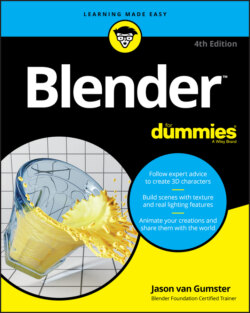Читать книгу Blender For Dummies - Jason van Gumster - Страница 92
Unlinking datablocks
ОглавлениеOf course, if Blender has a way to create links and duplicates, you’d logically (and correctly) think that you can convert a linked duplicate into an object with its own, non-shared datablock. In Blender, this process is called giving that datablock a single user.
The reason for the single user terminology goes back to how these datablocks are tied together. From the perspective of the datablock, each object that’s connected to it is considered a user. Refer to Figure 4-12: Each Cube object is a user of the Suzanne datablock. By choosing to use the Make Single User operator, you’re effectively telling Blender to duplicate that datablock and make sure that it connects to only a single object. To make an object have single user data, select the object you want and then choose Object ⇒ Relations ⇒ Make Single User in the 3D Viewport’s header. You see a menu with the following options:
Object: Use this option when you have an object linked to multiple scenes and you want to make changes to it that appear only in the specific scene that you’re currently working on.
Object & Data: For cases like the preceding example with the linked Suzanne meshes where you have a linked duplicate that you’d like to edit independently of the other meshes, choose this option. Doing so effectively converts a linked duplicate into a regular duplicate.
Object & Data & Materials: If you have an object that is not only sharing internal object data with others, but also sharing material settings, choose this option, and both those datablocks are duplicated and singly linked to your selected object. Using this option is a pretty good way to make sure that your selected object isn’t sharing with any other objects at all.
Materials: In cases where you no longer want to share materials between objects, choosing this option makes sure that your selected object has its own material settings independent of all the other objects.
Object Animation: This option is the inverse of the Make Links ⇒ Animation Data option. If your selected object is sharing actions with any other objects, choosing this option makes sure that it has actions of its own.
Another way to make object data a single user is to use the datablock buttons in Blender’s interface. In Figure 4-10, the number 3 is highlighted, showing that three objects share that particular datablock. If you left-click that number, you make that a single user datablock. This little button shows up in many places throughout the Blender interface. The datablocks that it operates on vary with context (for example, seeing this button in the Material tab of the Properties editor means that it’s working on a material datablock; seeing it in the Dope Sheet means that it’s working on actions, and so on), but it always means the same thing: Create a datablock like this one that has only the selected object as its user.
There is one other way to make object data a single user: Use the Outliner. Right-click an object data entry and choose ID Data ⇒ Make Single User from the menu that appears. There are a few datablocks (such as material actions) where this is the only clear way to make them single user.
